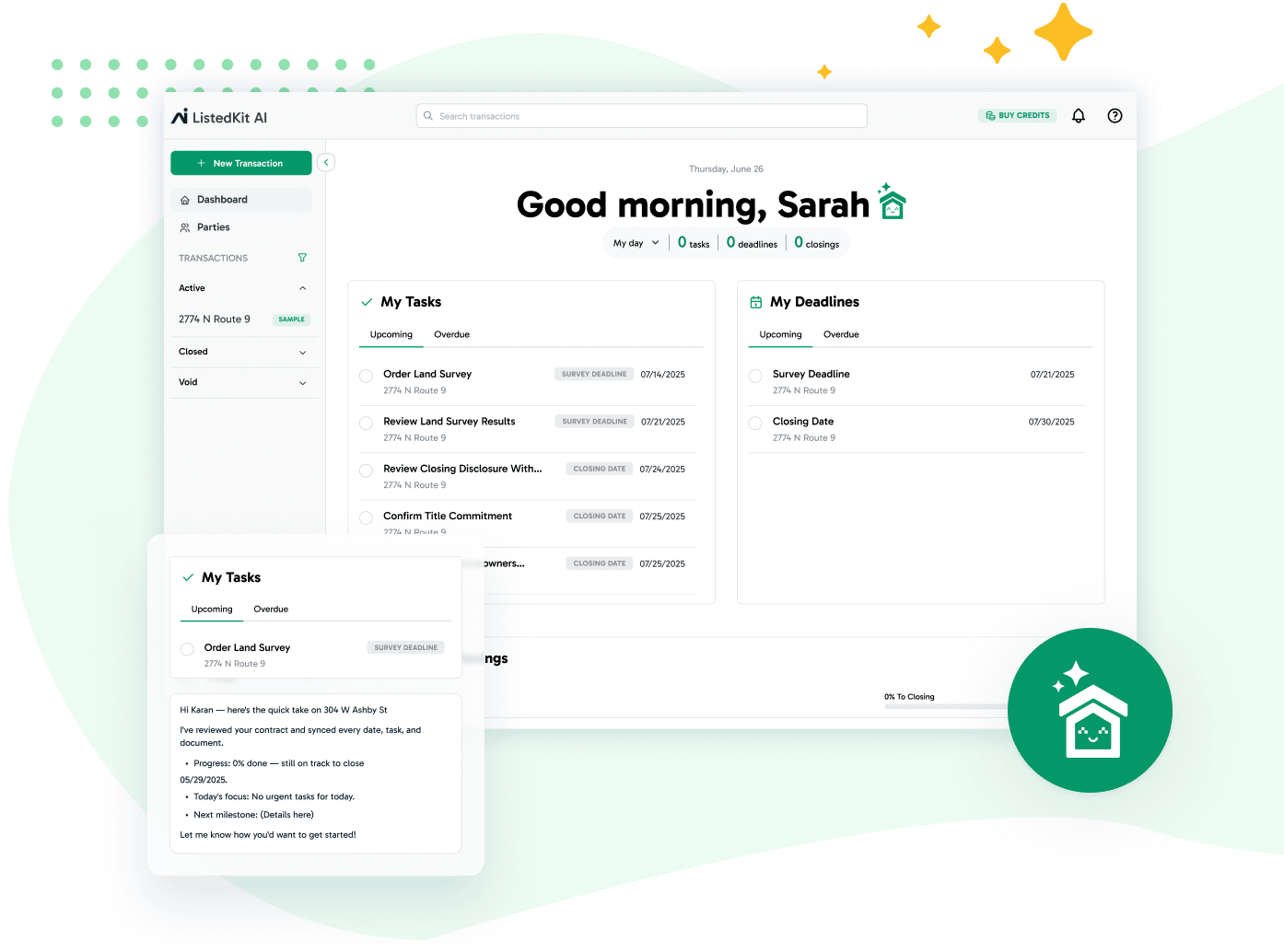Transaction coordinators in the real estate industry often face significant challenges with new client relationships. Misaligned expectations, varying communication styles, and unfamiliar workflows can make the initial phase of collaboration tricky.
Enter the 3-transaction rule—a practical approach to syncing with new clients. This concept posits it takes about three real estate transactions to fully understand a client’s preferences, communication style, and expectations.
This article provides actionable tips and insights to help transaction coordinators streamline their onboarding processes, improve client satisfaction, and create long-term, collaborative relationships.
Understanding the 3-Transaction Rule
The 3-transaction rule suggests that the learning curve for transaction coordinators and clients requires three real estate transactions to align workflows, preferences, and expectations.
While onboarding lays the foundation, practical experience with actual transactions is what truly helps establish strong client relationships.
Why Three Transactions?
- Adapting to Communication Styles. Every client—whether they are independent agents, sellers, or buyers—has unique communication preferences.
- Some clients may prefer detailed updates via email, while others might favor quick text messages or calls for urgent matters.
- Their tone and response time may also vary; recognizing these subtleties ensures smoother, more personalized interactions moving forward.
- Through these transactions, TCs can fine-tune their approach to meet the client’s unique expectations and communication habits.
- Understanding Preferences. From document formatting to preferred workflows, these details become clearer with active collaboration.
- Clients may prefer a certain level of detail in reporting, such as summarizing critical points versus providing exhaustive updates.
- Some might favor specific templates or tools that streamline document management and submission.
- Gaining clarity on these preferences allows for a more tailored and efficient process that aligns with their goals.
- Building Rapport. Trust is earned over time, and by the third transaction, both parties often feel more confident in their working relationship.
- Consistently delivering on deadlines and promises builds credibility and reassures clients that you are reliable.
- Addressing concerns promptly and proactively identifying potential issues shows a commitment to their success.
- By the third transaction, clients begin to view the coordinator not just as a service provider but as a trusted partner in the process.
Benefits of the Rule
- Streamlined Workflows. Each transaction builds upon the last, optimizing processes for efficiency and saving time.
- Recurring tasks, such as preparing settlement documents or tracking deadlines, become more automatic as you refine workflows.
- Coordinators can also identify bottlenecks early and introduce adjustments, such as automated reminders or better task delegation, to improve speed and accuracy.
- Enhanced Client Satisfaction. When clients feel heard and understood, their satisfaction increases, making them more likely to return or refer others.
- Listening to feedback after each transaction and incorporating their suggestions can make clients feel valued.
- Being proactive in anticipating their needs—such as offering resources or guides for future transactions—goes a long way in ensuring they’re delighted with your service.
- Stronger Relationships. Successfully navigating the first three transactions lays the groundwork for future collaboration, paving the way for a long-term partnership.
- By developing a shared understanding of processes and preferences, you reduce the likelihood of friction in future interactions.
- Strong relationships often lead to repeat business, referrals, and trust in more complex transactions, such as managing real estate closings or addressing title issues.
Common Challenges in the First Three Transactions
The initial onboarding phase in the real estate sector often brings challenges that can impact both the coordinator and the client. Addressing these issues early ensures smoother collaboration.
Misaligned Expectations
- Challenge: Clients, including real estate professionals and insurance intermediaries, may have differing expectations about timelines, deliverables, or roles.
- Solution: Use an onboarding checklist to clarify the process and manage expectations. Share clear timelines for each transaction to avoid confusion.
Communication Gaps
- Challenge: Real estate clients often use different communication tools or have varying preferences, leading to misunderstandings.
- Solution: Establish communication protocols early. Ask questions like, “What’s your preferred platform for updates—email, phone, or task trackers?”
Navigating Complex Requirements
- Challenge: Variations in local regulations, title issues, and settlement processes can complicate early transactions.
- Solution: Provide clients with resources, guides, and templates to bridge knowledge gaps. Be proactive about clarifying requirements related to settlement statements and real estate closings.
Strategies to Sync with New Clients in Three Transactions
The 3-transaction rule allows transaction coordinators to refine their workflows and ensure strong client relationships. Here’s how to navigate each phase:
First Transaction: Establish the Foundation
Your first transaction is the cornerstone of a working relationship. It’s an opportunity to set expectations, clarify roles, and establish a workflow that will guide future transactions.
Initial Meeting:
- Discuss goals, timelines, and expectations for the transaction to set a clear direction.
- Introduce your workflow and clarify your role in the real estate business, ensuring the client understands how you will contribute to their success.
- Document client preferences, including any unique requirements for the real estate markets they operate in.
Provide Clear Guidelines:
- Share an onboarding packet or checklist tailored to the client’s specific needs and expectations.
- Provide an overview of important milestones and key deliverables to keep the client informed throughout the transaction.
- Offer a visual workflow or timeline (e.g., a Gantt chart) to give the client a clear picture of the process from start to finish.
Set Communication Standards:
- Agree on communication tools and frequency (e.g., weekly email updates, daily progress reports, or shared task trackers).
- Confirm the client’s availability during business days to establish realistic expectations for responses and updates.
- Determine escalation protocols for urgent matters, ensuring both parties know how to address time-sensitive issues.
Second Transaction: Fine-Tune the Process
The second transaction is an essential opportunity to adjust workflows and ensure alignment with the client’s unique needs. It allows transaction coordinators to refine their approach for greater efficiency and improved collaboration.
- Review Lessons Learned:
- Analyze the successes and challenges of the first transaction, identifying areas for improvement.
- Gather feedback from the client to better understand their expectations and refine your processes.
- Identify bottlenecks or delays and develop strategies to address them moving forward.
- Introduce Collaborative Tools:
- Use shared platforms like Google Drive or Trello to centralize documents and track task progress transparently.
- Set up automated reminders for deadlines to ensure all parties remain on schedule.
- Provide a quick tutorial or overview of any tools introduced to ensure the client feels confident using them.
- Simplify Processes:
- Customize templates based on client preferences to streamline communication and documentation.
- Highlight key milestones with clear timelines to keep clients informed and engaged throughout the process.
- Remove redundancies in workflows, focusing on tasks that add value and reduce unnecessary steps.
Third Transaction: Optimize and Review
The third transaction is where all the pieces come together. This phase provides an opportunity to evaluate the overall process, implement final adjustments, and solidify a strong working relationship with the client.
By this point, you should have enough experience with the client to fine-tune your workflows and ensure long-term collaboration runs smoothly.
- Evaluate Workflow Efficiency:
- Review overall performance and client satisfaction by comparing the transaction’s outcome to initial goals and expectations. Identify areas where workflows succeeded and areas needing improvement.
- Analyze specific steps in the process to pinpoint inefficiencies, such as delays in document submission or bottlenecks in communication.
- Confirm whether tools and processes implemented during earlier transactions are enhancing efficiency or if further optimization is required.
- Hold a Feedback Session:
- Schedule a feedback meeting with the client to discuss their experience across the three transactions. This session is a valuable opportunity to gather insights directly from the client.
- Ask targeted questions such as, “What part of the process did you find most helpful?” or “Is there anything we could do differently next time?”
- Use the feedback to identify adjustments that align with client preferences and enhance their overall satisfaction, ensuring they feel heard and valued.
- Finalize Adjustments:
- Update your workflows to reflect client preferences and feedback, incorporating changes that will improve the process for future transactions.
- Create a detailed record of the client’s preferences, communication style, and specific needs to reference in future collaborations.
- Solidify standardized processes and templates for recurring tasks, ensuring a consistent and seamless experience in subsequent transactions.
Scenario: The First Three Transactions with a New Client
Let’s explore how the 3-transaction rule might play out for a transaction coordinator working with a new real estate agent:
First Transaction : The Introduction
- Challenge: The agent struggles with meeting document deadlines, leading to delays.
- Solution: Introduce automated reminders and provide a checklist for document submission timelines.
Second Transaction: Adjusting the Workflow
- Challenge: Miscommunication occurs due to scattered updates across multiple platforms.
- Solution: Centralize communication using a shared task tracker and set expectations for update frequency.
Third Transaction: Building Alignment
- Challenge: The agent requests specific changes to the settlement process.
- Solution: Incorporate their feedback into templates, finalizing a workflow that suits their needs.
By the third transaction, the coordinator and agent have established trust, aligned workflows, and built a collaborative relationship.
The Role of Communication in Effective Onboarding
Effective communication is essential for navigating the onboarding phase. Here’s why it matters and how to improve it:
Why Communication Matters
- Minimizes Misunderstandings. Clear updates reduce errors and ensure both parties are aligned.
- Builds Trust. Regular check-ins demonstrate reliability and professionalism.
- Encourages Collaboration. Transparent communication fosters a sense of partnership.
Tips for Better Communication
- Use Clear, Concise Language:
- Avoid jargon unless the client is familiar with real estate reports or legal terms like “fiduciary standard.”
- Focus on actionable updates.
- Check In Regularly:
- Schedule consistent updates during key phases of the real estate transactions.
- Use reminders to keep clients on track with deadlines. You can use tools like ListedKit for this.
- Centralize Communication:
- Use platforms like Trello, Slack, or email threads to keep conversations organized.
- Avoid scattered communication across unrelated channels.
Build Stronger Client Relationships with the 3-Transaction Rule
The 3-transaction rule offers a proven framework for transaction coordinators to establish trust, refine workflows, and create lasting, productive relationships with their clients.
By focusing on learning, adjusting, and optimizing during the first three transactions, coordinators can ensure smoother processes and higher client satisfaction, ultimately building a foundation for long-term success.
Recap of Key Insights:
- Lay the Foundation. Set clear expectations, establish communication protocols, and provide structured guidelines to ensure alignment from the outset.
- Refine the Process. Use feedback and experience to adjust workflows, streamline repetitive tasks, and introduce collaborative tools that enhance efficiency.
- Optimize and Solidify. Review performance, gather client feedback, and implement final adjustments to create a seamless and reliable process for future collaborations.
By following this framework, transaction coordinators can address challenges proactively, foster strong client relationships, and position themselves as indispensable partners in the real estate industry.
Streamline your back-end system and onboard agents effectively with ListedKit, the tool designed to simplify transactions and ensure success.




